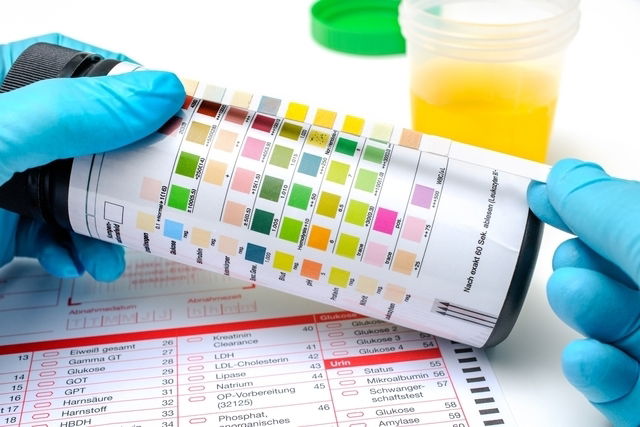Leukocytes in the urine in small quantities is a normal finding. However, high levels of leukocytes in the urine can be caused by a UTI, kidney problems, lupus, or even cancer.
High leukocyte levels in the urine are usually detected in a a urinalysis (also known as a “routine and microscopy” or “R & M”). This urine tests also looks other urine characteristics, like red blood cells, epithelial cells, microorganisms and proteins, all which can help to identify a diagnosis.
It is normal to have 0 to 5 leukocytes per microscopic field or 10,000 leukocytes per ml of urine - this range is not considered to be significant. However, the doctor may order further testing if other abnormalities are noted in the urine (e.g. blood, epithelial cells or foul odor) or if the patient presents with symptoms, like burning with urination, abdominal pain, or interrupted urine strep.

What causes leukocytes in the urine?
Leukocytes can be noted in the urine for the following reasons:
1. UTI
A urinary tract infection (or UTI) is the most commonly occurring reason for increased levels of leukocytes in the urine. High levels indicate that the immune system is trying to fight off a fungal, bacterial or parasitic infection by fungus.
With infection, other characteristics will also be noted in the urine, such as the presence of epithelial cells and the microorganism responsible for the infection. Learn more about UTI symptoms and check-out our online symptoms quiz to assess your risk.
What to do: If infection is suspected, the doctor will likely order a urine culture test, which is a urine test that attempts to isolate and identify a possible microorganism that is causing the infection. Depending on the microorganism, the doctor will then recommend indicated treatment. If a bacterial infection is confirmed, for example, and the patient is symptomatic (e.g. pain and burning with urination, discharge, etc.), the doctor may prescribe antibiotics. Read more about the UTI treatment options your doctor may consider.
If a fungal infection is confirmed, the doctor will likely prescribe antifungal medication, such as fluconazole or miconazole. The medication chosen depends on the type of fungus identified. If parasites are the cause of the infection, (e.g. Trichomonas sp, which is the most common type of parasitic infection), the doctor will likely treat with metronidazole or tinidazole.
2. Kidney problems
Kidney dysfunction, as is seen with nephritis or kidney stones, can also cause elevated levels of leukocytes in the urine. Kidney problems can also leads to crystals in the urine or, sometimes, red blood cells.
Both nephritis and kidney stones may also present with some characteristic symptoms such as back pain, difficulty peeing and decrease in the quantity of urine.
What to do: If you suspect you have kidney stones or nephritis, it’s important to see your doctor or a urologist. They will likely order an ultrasound and urine testing in order to identify the the reason for the increase in leukocytes and start the appropriate treatment. Complete our online kidney symptoms quiz to determine your risk for kidney disease.
3. Systemic lupus erythematosus
Systemic lupus erythematosus is an auto-immune disease, which means it’s a condition where the immune cells attack the body, causing joint, skin, eye and kidney inflammation. In the presence of this disease, urine testing will often show high levels of leukocytes. This combined with CBC blood testing can help with diagnosis.
Learn more about the symptoms of lupus and what can cause it.
What to do: Correcting leukocyte levels in the urine is typically done under medical supervision. Usually, the doctor will prescribe medication according to the symptoms presented by the patient, such as anti-inflammatory medication, corticosteroids, or immunosuppressive drugs. In short, by managing symptoms related to lupus, it is possible to decrease urine leukocyte levels.

4. Use of medication
Some types of medication, such as antibiotics, aspirin, corticosteroids, and diuretics can cause elevated leukocyte levels in the urine.
What to do: If you are taking any type of medication that may be causing an increase of leukocytes in the urine, it’s important to bring your concern to your prescribing doctor.
5. Holding urine
Holding urine for long periods of time can promote the growth and development of microorganisms, resulting in a urinary tract infection and causing leukocytes to appear in the urine. In addition, if you hold urine for too long, your bladder will begin to weaken overtime and eventually will be unable to empty completely. This causes urine to pool inside the bladder, causing microorganisms to grow.
What to do: If you suspect this might be the cause, it’s important that you relieve yourself as soon as you feel the urge to pee. This will prevent the accumulation of urine and microorganisms in the bladder. In addition, to prevent infections from occurring, it is recommended that you drink at least 2 liters (about 8 cups) of water per day.
6. Cancer
Although it is not as frequently occurring, bladder, prostate or kidney cancer can weaken the immune system and lead to elevated leukocyte levels in the urine. In addition, leukocytes can appear as a side effect of cancer treatment.
What to do: The presence of leukocytes in the urine is common finding in urinary tract or genital cancers. If you have cancer and your levels happen to be elevated, your doctor will likely keep checking urine leukocytes levels as a way of tracking disease progression as well as your body’s response to treatment. Read more about the cancer blood tests your doctor may order to rule out this disease.
Urine testing
The urine leukocyte levels are verified through macro and microscopic analysis, which identifies the presence of abnormal characteristics, such as crystals, epithelial cells, mucous, bacteria, fungi, parasites, leukocytes and red blood cells.
The normal levels of leukocytes in the urine is 0 to 5 leukocytes per field. There may be higher amounts in women depending to their age and menstrual cycle. When there are more than 5 leukocytes per field, the sample is identified as "pyuria", which describes that there are high levels of leukocytes in the urine. In these cases, it’s important for the doctor to compare the pyuria with other results in the urine test, as well as compare urine results with the results of the blood tests and the microbiological tests that he or she may have requested.
Before carrying out a microscopic test, the reagent test is done to indicate certain characteristics of the urine, including the leukocyte esterase, which is a reagent when there are a lot of leukocytes in the urine. Even though this signals pyuria, it’s important that the quantity of leukocytes seen in the microscopic test be communicated.








